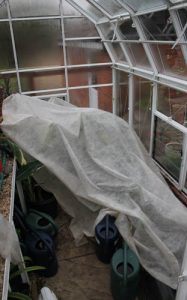Dear Weather, please can you consider the date and change from your April angst to something more akin to the month of May flowers. Thank you.

The soil is still cold from rainfall and frosty nights, so greenhouse sowings in pots and modules, over the previous weeks will be well rewarded. Outdoors, once the soil has warmed, germination will be rapid and even though the season is late, there is still plenty of time to catch up. Covering seedbeds with black polythene absorbs heat from the sunshine and warms up the soil, seeds can then be sown under protective fleece or cloches.
‘Hardening off’ or acclimatising greenhouse grown plants to outdoor conditions is important. Put them straight out into the garden and they suffer from shock, most recover but it checks growth and causes sensitive crops to run to seed. ‘Hardening off’ takes two to three weeks, depending on the plant, the temperatures at which it grew while under cover and the garden’s location. Hardy plants acclimatise more rapidly than half-hardy or tender plants.
Transfer plants from heated to cooler conditions on a cloudy day, if possible or cover them with newspaper or fleece initially to prevent them from scorching or wilting. Techniques depend on the facilities available. Plants raised in a heated glasshouse or on windowsills ideally should be moved into a cold glasshouse for two weeks, then into a well-ventilated cold frame for a final week. If you do not have a glasshouse, move plants into a cold frame. Open it a little during the day and close it at night, increasing ventilation gradually over time and remove the cover a few days before planting. Cover cold frames with carpet or hessian if late frost is forecast. If you do not have a cold frame, place plants at the base of a sheltered, south facing wall or hedge, or somewhere sheltered during the day, protected for the first few days a couple of layers of fleece. Bring plants indoors at night, in the first week, and use a single layer of fleece for the first part of week two. After about 10 days, depending on the weather, remove the fleece during the day and leave plants outdoors at night if it’s mild. Leave them uncovered towards the end of the third week, before finally planting out.
Timing is critical: tender plants should not be planted out until after the last frost in your area. Listen to weather forecasts and have temporary protection, such as cloches, fleece or newspaper, ready should late frosts occur. At the moment I am keeping my tender plants under fleece in the greenhouse at lower temperatures to start the process of hardening off and reduce heating. Tender plants can be damaged if hardened off’ below 12C(54F), Petunia, lobelia, Tagetes need temperatures around 10-12C (50-54F), tender bedding like pelargoniums and Bizzy Lizzie, can be planted when minimum night and day temperatures are 10C (50F) and 14-16C (57-61F) respectively. With a little care you will still have a beautiful garden, when the weather finally improves.
Happy Gardening, Matt


